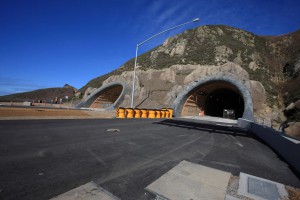California is home to awe-inspiring tunnels, from the Yerba Buena Island Tunnel, the world’s widest single-bore tunnel, and the Wawona, the state’s longest tunnel highway, to the famous 2nd Street Tunnel, the Los Angeles landmark that makes frequent guest appearances in movies like Blade Runner and countless car commercials. Yet a new tunnel highway hadn’t been built in the state for over 50 years – and one was desperately needed in the Bay Area, where a cliff-hanger roadway led to tragic accidents, broken roads and staggering costs for years. Enter the Tom Lantos Tunnels.

World, meet the brand-new Tom Lantos tunnels, just south of San Francisco. Courtesy the California Department of Transportation.
Bay Area drivers and transportation enthusiasts alike will appreciate the newest and, incidentally, the sleekest addition to the California landscape. The AP reports that the Tom Lantos Tunnels – two mile-long, 30-foot wide tunnels that will divert drivers along Route 1 away from Devil’s Slide, a cliff-hanging region that brims precariously above the ocean just south of San Francisco – are complete and undergoing final safety tests.
The region known as Devil’s Slide, so named for the cliffs that begin to slide during rainfall there, is as dangerous as the surrounding scenery is gorgeous. Route 1 runs between the towns of Montara and Pacifica through the Slide, a 1.2 mile-long precipitous area marked by landslides and rock slides that have resulted in deadly accidents, road closures and expensive repairs over the years. A 1995 closure lasted 158 days and cost nearly $3 million in repairs. More recently, heavy rainfall in 2006 led to rock slides that tore apart the road, resulting in a four-month closure and $7 million in repair expenses.
The road has fallen nine times since its original installation in 1937, completely cutting off communities like Half Moon Bay and Montara. Worse still, the roadway’s jagged twists and turns means that drivers must slow down to less than 25mph – faster drivers risk crashing hundreds of feet down the cliffs, or colliding into oncoming traffic.
The new tunnels circumvent the treacherous and aptly named Devil’s Slide. Via jitze; licensed under Creative Commons.
Drivers can now expect a much safer drive: the straight path through the concrete Tom Lantos Tunnels is complete with 12-foot wide single traffic lanes, 8-foot right shoulders, and 2-foot left shoulders. Safety features include 10 fireproof shelters, cameras overseen by a 24-hour team, exhaust fans and carbon monoxide sensors. Then there’s the aesthetic appeal: gleaming white walls and a convex ceiling evoke European design, while, outside, faux boulders created by the designer behind the Indiana Jones Ride at Disneyland adorn the entryway.
Paid for with $439 million in federal emergency funds, the project features a 1,000-foot bridge at the northern end over the valley at Shamrock Ranch. The southern section of Route 1 is also reworked to guarantee drivers’ secure transit in and out of the tunnels. A maintenance facility is located nearby.
The project, which was set to be unveiled in late 2012, broke ground in 2007 after decades of debate between residents, environmentalist groups and the state. Using innovative tunnel-digging techniques imported from Austria, which excavates three to six feet of ground at once, the engineers discovered a host of geographic and terrain issues associated with the mountain that pushed back the project’s completion date.
The Tom Lantos Tunnels add to California’s already impressive roster of tunnels. From RoadTrafficSigns.
The project provides a largely environmentally-friendly alternative to a previously proposed solution: a highway that would’ve run through the surrounding rural area, which, many residents feared, would lead to large-scale suburban development. Environmentalists were also concerned initially that the project would destroy the natural landscape, contribute to noise pollution, and harm local wetlands and wildlife. Certain features of the project aim to reduce environmental impact, such a greenery-carpeted roof.
The now-closed road near Devil’s Slide will be converted into a walking and biking trail after the tunnels’ official opening, transforming the once-deadly area into a safe – and green – respite.